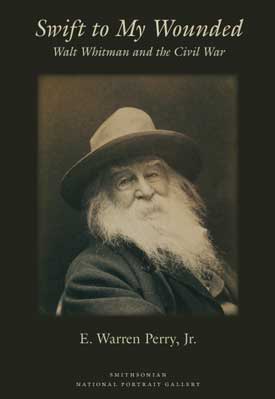Adapting Whitman to the Stage: Swift to My Wounded
 The National Portrait Gallery’s first dramatic publication, Swift to My Wounded: Walt Whitman and the Civil War, is now available at the NPG museum shop and also online.
The National Portrait Gallery’s first dramatic publication, Swift to My Wounded: Walt Whitman and the Civil War, is now available at the NPG museum shop and also online.
Whitman’s experiences in Washington are at the very core of his poetry and his journals. After his brother George was wounded at Fredericksburg in December of 1862, Walt Whitman came south from Manhattan and began work as a volunteer. He spent time with soldiers recovering in the Patent Office Building (now home to the National Portrait Gallery and Smithsonian American Art Museum), which had been converted into a hospital for much of the Civil War.
Whitman later worked in the building as a clerk for the Department of the Interior until he was fired by Secretary James Harlan in June 1865. Swift to My Wounded is a dramatic interpretation of those experiences as well as Whitman’s thoughts on the assassination of President Abraham Lincoln.
In 2007 Swift to My Wounded was staged again at the McEvoy Auditorium, and in November 2008 the show was performed in the National Theatre’s Helen Hayes Gallery.
*****
The following is from the National Portrait Gallery’s Profile magazine. It was written by Warren Perry, NPG researcher and playwright, and discusses the making of Swift to My Wounded:
The goal of every playwright is very simple: keep the audience from leaving. Adapting a biography for the stage is similar to creating an original drama in that the writer/adaptor’s primary task is to make the work compelling and vital.
Three years ago, Tom Donahue, chairman of the Catholic University Drama Department; Bill Largess, artistic director for the Washington Stage Guild; and Jewell Robinson, director of public programs for the National Portrait Gallery, decided to produce a play based on Walt Whitman’s Civil War experiences for the 2006 reopening of the National Portrait Gallery. I was honored to be asked to participate and was given the job of adapting Whitman’s works for the stage.
To create the play that became Swift to My Wounded from Whitman’s poetry and journals—two obviously non-theatrical genres—I first organized Whitman’s original work into a sequence of events that the character Walt Whitman could reflect upon and discuss. Next, I added transitions and embellishments to the original language. This second process was a delicate act—after all, who would presume to think that the addition of his or her language could enhance Walt Whitman’s own words?
Still, a quick analysis of Whitman’s writing yields a very interesting note: Walt Whitman was a list maker. Both his poems and his journals are marked by lists—lists of battlefields, lists of states in the Union, lists of plants and flowers, lists of parts of the human body—limitless lists of all kinds. Consider this passage from When Lilacs Last in the Dooryard Bloom’d:
Lo, body and soul—this land,
My own Manhattan with spires, and the sparkling
and hurrying tides, and the ships,
The varied and ample land, the South and the
North in the light, Ohio’s shores and flashing
Missouri,
And ever the far-spreading prairies cover’d with
grass and corn.
Other than a splendid description of Whitman’s America, this partial stanza of forty-eight words contains a list of places and rivers (Manhattan, the South, the North, the Ohio, the Missouri), a list of characteristics of Manhattan (spires, tides, ships),and two things found on the prairie (grass, corn).
The beauty of these observations serves poetry well, but it does not necessarily work as well for the stage and for keeping the audience’s attention. Whitman’s journals are even more intensively loaded with lists than his poetry. At this point in the development of the work, I wrote several original passages into the play to reflect the topicality of Whitman’s war commentary, and to provide a storyline into which his journals and poetry could be interpolated.
Ordinarily, from a writer’s point of view, the work would then be complete, except for the suggestions and notes of an editor. Writing for stage, however, is unlike writing for print, and the collaborative input of the producer, the director, and the actor mandated some revisions and changes to the arc of the storyline, all of which served the first rule of drama, which is, of course, to keep the audience from leaving.
For more on Whitman, see this previous blog post, as well as the website for NPG's former exhibition "One Life: Walt Whitman, A Kosmos." And learn more about history of the Patent Office Building in the NPG's online exhibition "Temple of Invention: A History of a National Landmark."